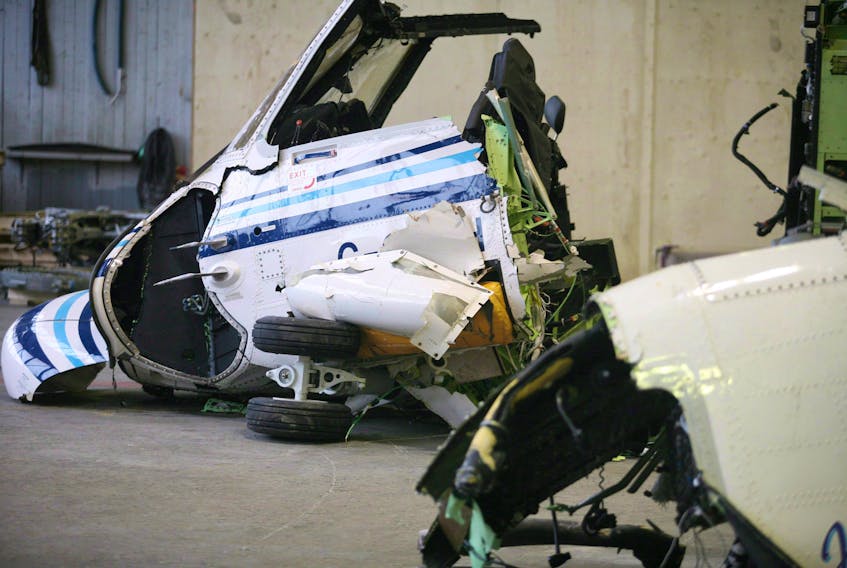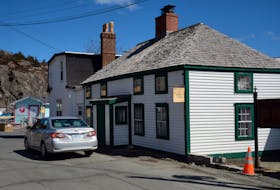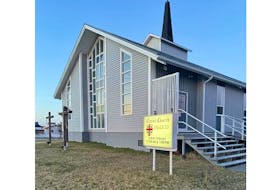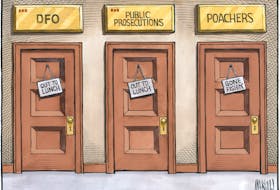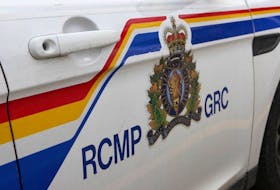Part-two of The Telegram's look at the first two decades of the 21st Century.
Offshore tragedy: Flight 491
The March 12, 2009 crash of Cougar Helicopters Flight 491 left 17 dead and just one survivor, Robert Decker.
The chopper crashed into the North Atlantic while transporting workers from St. John’s to the Husky SeaRose floating production, storage and offloading vessel.
Those who died were Matthew Davis, John Pelley, Corey Eddy, Tim Lanouette, Thomas Anwyll, Peter Breen, Gary Corbett, Wade Drake, Wade Duggan, Colin Henley, Ken MacRae, Derrick Mullowney, Burch Nash, Paul Pike, Allison Maher, Keith Escott and Gregory Morris.
In November 2009, Decker told the inquiry into the crash that after the order to brace, the call by the helicopter pilots of “ditching, ditching, ditching,” came almost as the helicopter was plunging nose-first toward the sea.

Decker said in his statement he has no memory of the actual impact.
“The next thing I could remember was waking up in a submerged helicopter. It was instantly filled with water. It was kind of as if it was sinking the same way it was dropping through the sky,” Decker testified.
Decker spent more than an hour in the frigid North Atlantic before being hoisted aboard a Cougar search and rescue chopper.
“I don’t think that anyone will ever know why it was that I survived this disaster and the others did not. There probably is no good reason — just luck,” Decker said in his statement to the inquiry.
The tragedy is remembered each year at a multi-faith service.
“I think people need this,” former airport chaplain John Ridgley told The Telegram in 2019. “Everyone was feeling this way — totally helpless, and all we could do was say to families, to fellow coworkers, we can’t take away your pain, but we’re here during your pain.”
The killing of Donald Dunphy
On Easter Sunday, April 5, 2015, Donald Dunphy was shot and killed in his Mitchell’s Brook home by Royal Newfoundland Constabulary officer Joe Smyth.
In June 2017, the Commission of Inquiry Respecting the Death of Donald Dunphy released its report.
Inquiry commissioner Justice Leo Barry found that, although Smyth made certain errors of judgment and did not always comply with aspects of his training, he responded with appropriate force when Dunphy threatened him with a rifle.
Smyth, who at the time of the shooting was a member of the protective services unit for the premier’s office, had visited the home of the 58-year-old disgruntled injured worker about certain comments Dunphy had posted to Twitter.
Smyth told the inquiry that when he was in the living room of Dunphy’s Mitchell’s Brook home, he looked down at a folder of papers for between two and six seconds, and when he looked up, Dunphy was holding a rifle.
“By the time I was focused on a firearm, it was pointed at me,” Smyth said. “I thought I was going to be shot.”
Dunphy’s daughter, Megan, told the inquiry her father kept a stick with a duct-tape handle for protection because he grew medical marijuana, and though an old gun was kept behind the sofa, it was never lying around the house.
“Dad pointing a gun at someone is not realistic to me. He had the stick. That was what he was going to use for protection if someone came in,” Megan Dunphy testified.
A Serious Incident Response Team (SIRT) for this province was among the recommendations stemming from the inquiry, and was announced in 2019, with defence lawyer Mike King named its first director.

The silver-haired set
Newfoundland and Labrador knew for the entire two first decades of this century and years before that it was facing a massive demographic shift as fewer babies were born and the population trended towards older people, some of whom would need more complex medical care and long-term care beds.
It’s the boomer phenomenon — as the baby boom of the 1940s to ’60s swells the senior population. Compounding this province’s conundrum are the lasting effects of outmigration after the cod fishery collapse in the 1990s.
While many people moved back home during the economic boom, those heady days didn’t solve the problem, and nor has immigration. Long gone are the times of large Newfoundland and Labrador families.
A Statistics Canada report in 2014 found that Newfoundland and Labrador, Nova Scotia and New Brunswick saw more deaths than births, resulting in a negative natural increase for the Atlantic region since 2013.
In 2019, the Newfoundland and Labrador Medical Association announced that 99,000 Newfoundlanders and Labradorians don’t have a family doctor.
The Canadian Institute for Health Information (CIHI) forecast per capita health-care spending for Newfoundland and Labrador in 2019 to be $8,190 (public and private combined). That’s the highest figure among all 10 provinces. The Canadian average is $7,068.
CIHI also said the 65-74 age bracket has steadily accounted for more and more of Newfoundland and Labrador’s health spending, reaching the 20 per cent mark in 2017.

House of scandal
In 2006, then auditor general John Noseworthy — after an examination of records from 1989 to 2005-06 — reported massive overspending by some members of the House of Assembly (MHAs) through their constituency allowances, including $2.2 million in inappropriate claims. There were claims for donations, alcohol, double billings and personal items. Millions of dollars more were spent with inadequate documentation. Kilbride Tory MHA Ed Byrne was found to have overspent his allowance by $326,642 over two years. MHAs Wally Andersen, Randy Collins and Jim Walsh were also implicated in overspending. All four ended up criminally charged.
In 2007, Noseworthy, reporting on MHAs who double-billed their constituency allowances, said that in 2004, each MHA received a payment of $2,875 as a bonus lump sum above the regular allowance, and it did not require receipts. Only two of the 48 MHAs did not take that payment — former premier Danny Williams and former MHA Elizabeth Marshall.
MHA Percy Barrett did not face criminal charges, but paid back $71,245 in constituency allowance overspending.
Civil servant Bill Murray was sent to federal prison in 2010, with a two-year sentence for his part in the spending scandal. He was convicted of fraud and accepting bribes — admitting to accepting kickbacks from MHAs, falsifying financial reports to the House and funnelling public money to local companies selling gift items.
Businessman John Hand was the owner/operator of companies selling items to MHAs, including keychains and pins, and ultimately pleaded guilty to charges of fraud and breach of probation.
As of February 2019, more than $2.6 million was still outstanding.

Hurricane Igor’s devastation
Some $110 million was estimated to have been spent on infrastructure repairs alone and more than $180 million in total damages related to September 2010’s hurricane Igor.
Igor stranded 90 communities as roads and bridges crumbled. The hardest hit places were Trinity Bay and the Bonavista and Burin peninsulas.
Allan Duffett of Lower Lance Cove was swept away Sept. 21, 2010, at the height of Igor when a section of road between Britannia and Lance Cove collapsed beneath him. His body was found three days later.
Rainfall from Igor was reported to range from a low of 41 millimetres in Burgeo to a high of 238 mm in St. Lawrence. Winds were estimated to be as high as between 120 and 140 kilometres an hour. Rivers, brooks, ponds and seas surged into homes and buildings, filling many with overturned oil tanks, the stench of sour water and even raw sewage.
States of emergency were declared as phone and power lines went down in numerous communities, leaving thousands without electricity for periods ranging from a few hours to several days.
Many communities ran out of gas and perishables such as milk, bread and baby formula.
Premier Danny Williams and Prime Minister Stephen Harper took a helicopter tour of the devastation, touching down in Igor-pummelled communities.
The Armed Forces, rolling in by truck, helicopter and naval vessels, helped put in Bailey bridges and deliver emergency supplies. The Red Cross, municipalities across the province, ordinary citizens, churches and other organizations pitched in with help and donations.
Igor prompted roughly 2,000 disaster assistance claims from homeowners, small businesses and non-profit organizations in its wake.

Glory on ice
In 2008, Danny Cleary became the first Newfoundlander to win the Stanley Cup, capping a remarkable turnaround in fortunes for the hockey pro. Just years earlier, Cleary was nearly out of the game. But he was on the ice when the Detroit Red Wings were crowned NHL champs.
In 2011, Michael Ryder became the second Newfoundland-born hockey player to win the Stanley Cup when the Boston Bruins dropped the Vancouver Canucks 4-0 in game seven.
Marystown native Kaetlyn Osmond won team gold at the 2018 Winter Olympic Games hosted by PyeongChang, South Korea. And in Milan, Italy, Osmond became the first Canadian woman in 45 years to win the world figure skating championship, following Karen Magnussen’s performance in 1973.
Liam Hickey made his Winter Games debut in 2018, helping Canada to the silver in para ice hockey.
The opiate crisis, drugs and guns
It wasn’t just a Newfoundland and Labrador tragedy, but one all of North America continues to struggle with — the opiate crisis and how it can bring drug culture into the smallest towns.
When OxyContin came onto the market, people who would have never touched an illicit drug become addicts overnight after being prescribed the powerful painkiller for injuries and chronic conditions.
During the height of the economic boom, cocaine became a popular recreational drug among the cash-rich in search of the trappings of the high life.
Then came deadly fentanyl, a synthetic opioid painkiller with a five-minute onset that’s up to 100 times more potent than morphine.
It the three years since the province began handing out Naloxone kits in to combat overdoses of fentanyl, an overdose which has the potential for immediate death, some 3,155 kits have been distributed as of September 2019.
The provincial government acknowledged opioid addiction as a public health crisis, and has established an action plan to address the issue.
Safe needle disposal containers are now a fixture in many public spaces, including public parks.
Drug dependency also fuels crime, including armed robberies, break and enters and home invasions and deadly relationships between criminals involved in the drug trade. Police news conferences on drug busts have displayed an artillery of heavy fire power, including handguns and sawed-off shotguns.

In just one example of how drugs feed crime, a 2013 drive-by shooting in a St. John’s subdivision, which targeted the wrong house, was connected by police to a suspicious firebombing and the local drug trade.
Early on May 31, a fire on Hamilton Avenue in St. John’s damaged two homes, as well as a Mercedes-Benz and a Harley-Davidson motorcycle parked in the driveway.
Late that night, two homes and three vehicles on Dauntless Street in Kenmount Terrace were damaged during a drive-by shooting involving an assault rifle believed to be an AK-47. The home’s occupants were not involved in the drug trade and the assailants apparently went to the wrong address in their attempt to retaliate.
Deadly drug addictions also led to murder.
For instance, Brandon Phillips, 30, who struggled with drug addiction, was convicted in 2017 of having murdered 63-year-old Larry Wellman during an armed robbery at the Captain’s Quarters Hotel in St. John’s in October 2015.
Wellman and his wife, who were visiting from Goose Bay, were in the hotel bar playing the VLTs when a masked man entered with a loaded, sawed-off shotgun and demanded money from the bartender.
Wellman, a former firefighter, was fatally shot when he attempted to intervene in the robbery, and later died in hospital.
Purdue Pharma, the company that brought OxyContin to the marketplace and set off an addiction crisis that has killed thousands in North America, filed for bankruptcy in 2019 in the wake of mass lawsuits.
With files from current and past reporters, as well as columnists Pam Frampton, Brian Jones, Russell Wangersky and Steve Bartlett
Stories that shaped N.L. in the 21st century: Part I
Stories that shaped N.L. in the 21st century: Part II
RELATED
- SPECIAL REPORT: The breast cancer testing scandal that shocked Newfoundland and Labrador led to sweeping change
- CAMERON REPORT: Donna Howell’s family left feeling shortchanged, 10 years after breast cancer testing scandal
- CAMERON REPORT: Elizabeth Finlayson remembered by her daughters
- CAMERON REPORT: Breast cancer testing scandal propelled passionate activism
- CAMERON REPORT: The breast cancer testing scandal in Newfoundland and Labrador affected many lives, including those working in the system that failed patients
- ANALYSIS: Muskrat Falls Inquiry evidence says we should demand better
- PAM FRAMPTON: Public the last to know the price of Muskrat Falls
- STEVE BARTLETT: Memories of 9-11 never fade
- For Brad Gushue, history is nice, but winning is what matters

